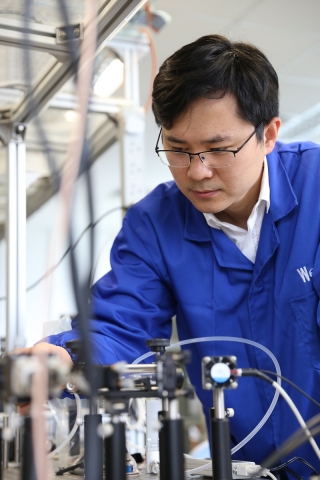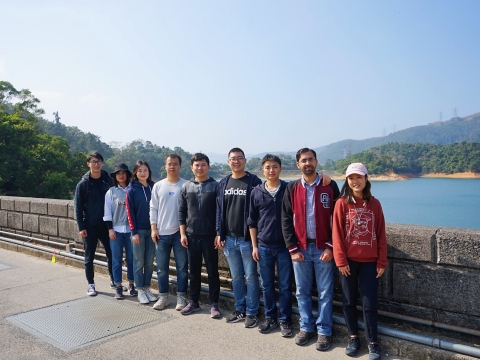A research team led by Prof. Wei Ren has adopted high-level quantum chemistry calculations to provide a definitive answer to the role of water vapour in some important atmospheric reactions. The new findings will enable a more accurate and reliable prediction of air pollution and atmospheric chemistry. Volatile organic compounds (VOCs) will produce ozone and fine suspended particulates (PM2.5) under photochemical reactions. In recent years, people in Hong Kong may have experienced fewer ‘blue sky’ days. One of the major reasons is the increasing emission of VOCs from the surrounding areas. Methanol is one of the most significant VOCs in the atmosphere with a global emission of 2.4 million tons. The lifetime of methanol in the atmosphere is about 3 to 14 days. Hydroxyl radical (OH), known as the ‘detergent’ of the atmosphere, is one of the most important species controlling the oxidizing capacity of the global atmosphere. It initiates most oxidation processes and removes the majority of gases emitted into the atmosphere including VOCs. Due to its significant environmental impact, scientists have been adopting numerous experimental and theoretical tools to understand some key oxidation reactions in the atmosphere. On this basis, reliable computational models can be constructed and used to predict air pollutions and atmospheric change. It has long been hypothesized that water vapour, with a concentration of 3% in the atmosphere, may play a role in atmospheric reactions involving VOCs oxidations. However, no direct evidence is reported until recently. In 2017, a research group in Argentina experimentally observed that the reaction of methanol with OH could be accelerated by a factor of two in the presence of high relative humidity. Thus they concluded that the water molecules affect the atmospheric methanol reactions. However, another research group from the French National Centre for Scientific Research claimed no catalytic effect of water vapour in their similar experiment. Doubt is cast on the possible role of water vapour in this reaction system. To clarify the role of water vapour in atmospheric methanol oxidation reactions, Prof. Ren’s team at CUHK worked with the University of Minnesota’s team adopting a high-accuracy quantum chemistry method and variational transition state theory to study the particular reaction involving methanol, hydroxyl and water vapour. With a thorough consideration of the high- and low-frequency anharmonicity, variational effect along the reaction path, and the quantum tunneling effect, the termolecular rate coefficients at 200 to 400 K were calculated. The theoretical calculation confirms that the catalytic effect of water vapour on the methanol and hydroxyl reaction is negligible in the atmosphere. The research work has been reported in the renowned scientific journal, Angewandte Chemie-International Edition and was highlighted as the Very Important Paper (VIP). (https://doi.org/10.1002/anie.202001065) Professor Ren said, “this research unveils a novel method for predicting atmospheric reactions. With the new dimension provided for the study of atmospheric reactions, we hope that in the future there will be a more accurate and faster application on monitoring air pollution in addition to the ultrasensitive trace gas sensors, leading to a higher quality alert system, and even better precautionary measures by the relevant corporations and authorities.” Additionally, Prof. Ren’s team explored the reaction rate coefficients of cyclopentane reaction with hydroxyl, which plays a significant role in fuel combustion and atmospheric degradation. This work exemplifies a valuable practice of extending the state of the art of treating anharmonicities in chemical reaction systems. This work has been recently published as Advance Article in Chemical Science-The Royal Society of Chemistry (https://doi.org/10.1039/C9SC05632G). |
|



